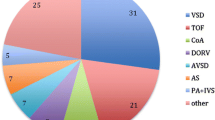Abstract
Coronary artery anomalies may increase the risk of sudden death. Despite awareness of this association with certain congenital heart anomalies such as tetralogy of Fallot and transposition of the great arteries, it is thought to be an infrequent finding in cases of isolated patent ductus arteriosus (PDA). The authors report their experience with coronary anomalies in PDA patients. This study aimed to estimate the incidence of coronary artery anomalies in patients with PDA. The study reviewed 206 angiograms of PDA patients obtained between 1999 and 2011 to determine the origin of the coronary arteries. In 102 angiograms (49.5 %), the origin of the coronary arteries could be adequately visualized. An anomalous origin of coronary arteries was detected in 11 of the 102 patients (10.8 %). Seven of these patients had a single common coronary artery origin (6.8 %). One patient had an aberrant origin of the left coronary artery from the noncoronary sinus, and three patients had an aberrant origin of the right coronary artery: two from the left coronary sinus and one from the noncoronary sinus. These findings suggest that the incidence of coronary artery anomalies in association with an isolated PDA may be considerably higher than expected and previously reported. In view of the increased risk for sudden death with coronary anomalies, a reasonable approach is to determine the coronary artery origin and pathway after the diagnosis of an isolated PDA.



Similar content being viewed by others
References
Alexander RW, Griffith GC (1956) Anomalies of the coronary arteries and their clinical significance. Circulation 14:800–805
Allen HD, Driscoll DJ, Shaddy RE, Feltes TF (2008) Moss and Adams’ heart disease in infant, children, and adolescents. Lippincott Williams & Wilkins, Philadelphia, pp 703–707
Baltaxe HA, Wixson D (1977) The incidence of congenital anomalies of the coronary arteries in the adult population. Radiology 122:47–52
Click RL, Holmes DR Jr, Vlietstra RE, Kosinski AS, Kronmal RA (1989) Anomalous coronary arteries: location, degree of atherosclerosis and effect on survival—a report from the Coronary Artery Surgery Study. J Am Coll Cardiol 13:531–537
Davis JA, Cecchin F, Jones TK, Portman MA (2001) Major coronary artery anomalies in a pediatric population: incidence and clinical importance. J Am Coll Cardiol 37:593–597
Eckart RE, Scoville SL, Campbell CL, Shry EA, Stajduhar KC, Potter RN, Pearse LA, Virmani R (2004) Sudden death in young adults: a 25-year review of autopsies in military recruits. Ann Intern Med 141:829–834
Giorgi B, Dymarkowski S, Rademakers FE, Lebrun F, Bogaert J (2002) Single coronary artery as cause of acute myocardial infarction in a 12-year-old girl: a comprehensive approach with MR imaging. AJR Am J Roentgenol 179:1535–1537
Hauser M (2005) Congenital anomalies of the coronary arteries. Heart 91:1240–1245
Jim MH, Siu CW, Ho HH, Miu R, Lee SW (2004) Anomalous origin of the right coronary artery from the left coronary sinus is associated with early development of coronary artery disease. J Invasive Cardiol 16:466–468
Kimbiris D, Iskandrian AS, Segal BL, Bemis CE (1978) Anomalous aortic origin of coronary arteries. Circulation 58:606–615
Kohsaka S, Makaryus AN (2008) Coronary angiography using noninvasive imaging techniques of cardiac CT and MRI. Curr Cardiol Rev 4:323–330
Maron BJ, Shirani J, Poliac LC, Mathenge R, Roberts WC, Mueller FO (1996) Sudden death in young competitive athletes. JAMA 276:199–204
Schmitt R, Froehner S, Brunn J, Wagner M, Brunner H, Cherevatyy O, Gietzen F, Christopoulos G, Kerber S, Fellner F (2005) Congenital anomalies of the coronary arteries: imaging with contrast-enhanced, multidetector computed tomography. Eur Radiol 15:1110–1121
Shirani J, Roberts WC (1993) Solitary coronary ostium in the aorta in the absence of other major congenital cardiovascular anomalies. J Am Coll Cardiol 21:137–143
Stoll C, Alembik Y, Dott B, Feingold J (1994) Parental consanguinity as a cause of increased incidence of birth defects in a study of 131,760 consecutive births. Am J Med Genet 49:114–117
Taylor AJ, Rogan KM, Virmani R (1992) Sudden cardiac death associated with isolated congenital coronary artery anomalies. J Am Coll Cardiol 20:640–647
Topaz O, DeMarchena EJ, Perin E, Sommer LS, Mallon SM, Chahine RA (1992) Anomalous coronary arteries: angiographic findings in 80 patients. Int J Cardiol 34:129–138
Vardi-saliternik R, Friedlander Y, Cohen T (2002) Consanguinity in a population sample of Israeli Muslim Arabs, Christian Arabs and Druze. Ann Hum Biol 29:422–431
Werner B, Wróblewska-Kałuzewska M, Pleskot M, Tarnowska A, Potocka K (2001) Anomalies of the coronary arteries in children. Med Sci Monit 7:1285–1291
Wesselhoeft H, Fawcett JS, Johnson AL (1968) Anomalous origin of the left coronary artery from the pulmonary trunk: its clinical spectrum, pathology, and pathophysiology, based on a review of 140 cases with seven further cases. Circulation 38:403–425
Wilkins CE, Betancourt B, Mathur VS, Massumi A, De Castro CM, Garcia E, Hall RJ (1988) Coronary artery anomalies: a review of more than 10,000 patients from the Clayton Cardiovascular Laboratories. Tex Heart Inst J 15:166–173
Won YJ, Kim HJ, Lee H (2011) Unexpected sudden death of a 19-year-old female with congenital single coronary artery ostium during exertion. Yonsei Med J 52:856–858
Yamanaka O, Hobbs RE (1990) Coronary artery anomalies in 126,595 patients undergoing coronary arteriography. Cathet Cardiovasc Diagn 21:28–40
Author information
Authors and Affiliations
Corresponding author
Rights and permissions
About this article
Cite this article
Dotan, M., Roguin, A., Sinyor, D. et al. Increased Incidence of Coronary Artery Origin Anomalies Associated With Isolated Patent Ductus Arteriosus. Pediatr Cardiol 34, 907–911 (2013). https://doi.org/10.1007/s00246-012-0569-0
Received:
Accepted:
Published:
Issue Date:
DOI: https://doi.org/10.1007/s00246-012-0569-0




